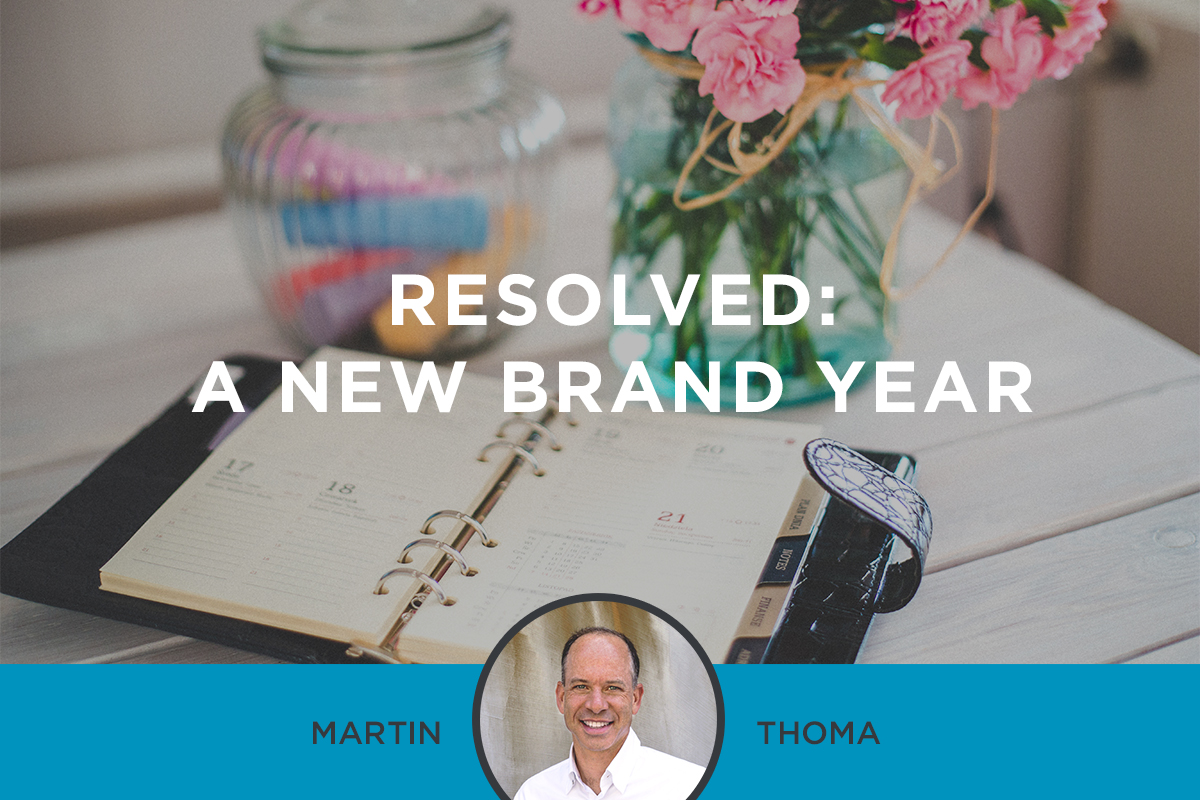The year 2016 is here and with it all the excitement of turning a new page on the calendar. What page might the brand leader turn?
I’m not thinking about a rebrand. That’s a once-in-a- (corporate)-lifetime experience at most. I’m thinking about incremental improvements that can drive quantum change in your brand power — something analogous to dropping 25 pounds, starting a meditation practice or healing a soured relationship.
Here are three top resolutions I believe can be applied by every brand leader in 2016 — no matter the size, maturity or sophistication of your organization today.
One: Understand Your Brand.
Leading a company and a brand requires continual communication, motivation and inspiration of the team. A risk is that we “read all of our own PR” and convince ourselves we’re something we’re not. A risk is that our self-perception is grossly misaligned with the world’s perception of our brand. The brand leader’s head is not where the brand lives! Brands live in the collective consciousness — in the minds of our customers and prospects “out there.”
The way to understand your brand stature is to ask the people. A brand assessment in 2016 will bring to the surface all sorts of actionable insight. Your study can be the one question of the Net Promoter Score, or it can be a comprehensive competitive assessment.
Using these tools for our clients, we’ve witnessed a lot of affirmation and many surprises. We’ve seen cases of inverted brand affinity in which customers and employers were much more invested in a company’s core brand value proposition than was its own senior team. We surprised a company’s leadership when its customers identified rock-star customer service and employee culture that the executives didn’t quite recognize. In another organization searching for its brand differentiators, we found that “there was no there there” as Gloria Steinem once said about Oakland.
Every such discovery is a jewel that can be faceted, polished and deployed to yield new brand leverage in your competitive space.
Two: Take A Stand For Your Brand.
Even executives who do a great job of designing and articulating their unique brand qualities eventually tire of banging the drum.
After a year or two or three, it’s easy to think the work is done. The logo’s right, the tagline works, the culture is aligned, the messaging resonates. Other, more urgent imperatives beckon and energy for the day-in, day-out of living the brand flags.
The situation is akin to saying, “We got the landscaping in — gorgeous new Zoysia lawn established, all the beds planted and manicured. No need to water or fertilize anymore.”
Brands are living, breathing things. They exist in the minds of our audiences. They require continuous care and feeding. So, how to do so in the new year?
Return constantly to the roots—reminding and repeating the “why” of your business and your brand. John Chambers, CEO of Cisco Systems during the high-growth 80s and 90s, said he spent a good part of every day moving about the company reminding everyone he contacted what Cisco was in business to do. Steve Jobs of Apple is a great example of fervent dedication to a company’s core purpose. Blake Mycoskie, the founder of TOM’S shoes just published a Harvard Business Review article on his journey back to purpose. Howard Schultz of Starbucks famously did the same in a memo decrying the use of machines that replaced baristas’ hand-crafted drinks.
One of our clients has championed an increase in employee alignment of 25 percentage points in the past two years. But he’s not letting off the gas with the internal work: “We know the risks of the program du jour,” he’s said.
Three: Clarify, Clarify, Clarify.
Can you say in 10 words or less what makes you different and desirable to do business with? Are you sure it matters and rings true to your customers? Most of us struggle with this because there’s a remarkable sameness to what we and our competitors do, especially when viewed from the outside. I recently had a prospect tell me, “we’ve interviewed three agencies and you all describe much the same work, often using the very same words. I’m still trying to understand the differences.” Ouch! More work to do. Even people working with these concepts every day get to learn every day.
Your organization is unique; every organization is. So your customers, employees and prospects deserve to know how and why. You deserve to be able to say how and why.
How do you do it? Some companies and leaders have an innate feel for it. I wrote about the founder of Geek Squad in my book. Robert Stephens intuited that taking a creative, cheeky slant on a pedestrian service business — fixing computers — would resonate. Most of us struggle with it. It took five years for our company to wrestle to the ground its unique Live Your Brand philosophy and methodology — and then some more time to bring our entire employee team into alignment. We’re still working on the market — as you and your brand will be for a very long time.
The final chapter of my book has a DIY recipe for clarifying brand uniqueness if you’d like to try it. I’ve put up a complimentary download to this chapter here. Caveat: like doing your own taxes, being your own attorney and pulling your own teeth this work is not for the faint of heart.
[Tweet “Your organization is unique. So your customers, employees and prospects deserve to know how and why.”]Welcome to 2016. Here’s to a new brand year for you and your organization.
This article was originally published in Talk Business.

